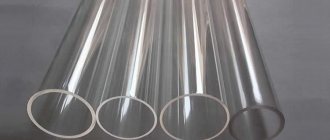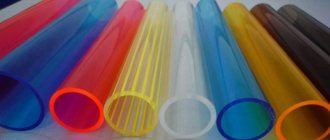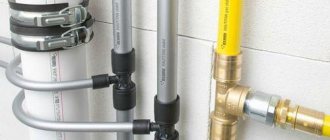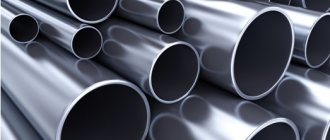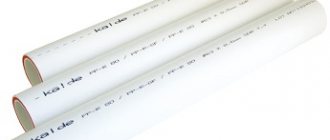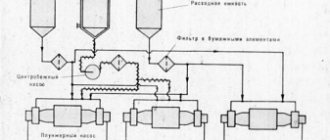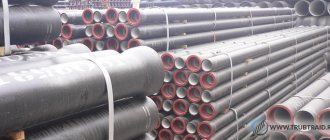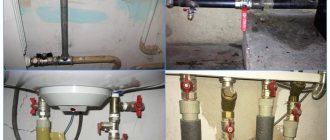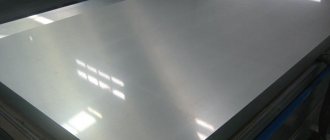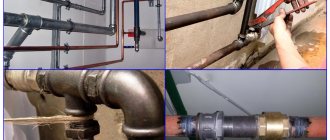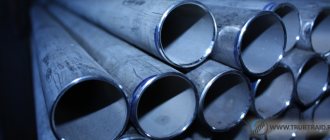Most of the Russian population still remembers Soviet-made cast iron risers and steel pipes. For some, they have not yet been replaced. Although technology has stepped far forward. Heavy Soviet pipe rolling has been replaced by the production of polypropylene pipes. Later - reinforced.
Polypropylene reinforced polypropylene (PPRC) is considered an innovative material. High elasticity and chemical and corrosion resistance, does not pose any harm to the environment and human health. The declared service life is 50 years. Both liquid and gas under high pressure can pass inside the pipe. And due to its low weight (compared to metal), there are significant budget savings on delivery and installation. Projects can be completed faster.
These advantages are a symbiosis of light but durable materials (polyamide/polyethylene) and production method. Polyester/aramid is permanently wound onto the inner layer. Thanks to synthetic threads, flexibility is maintained.
What is reinforced PP pipe
Among all organic polymers, polypropylene occupies a special place. It creates durable and non-hazardous products. The disadvantages of non-reinforced material include sagging and deformation changes in pipelines when a very hot liquid medium moves through them.
Reinforced polypropylene
The disadvantage of simple polypropylene is also linear thermal expansion. This disadvantage creates significant inconvenience during the operation of polymer heating networks or PP pipelines with hot water.
In communications, the length of pipes can increase to 10 mm per 1000 mm. Therefore, compensators must be installed in them to stabilize the elongation.
Due to the linear expansion of PP pipes, the appearance deteriorates and the cost of openly laid systems increases. When laying closed, there is a possibility that the integrity of the plaster layer will be damaged.
Reinforcement is a technology for strengthening rolled pipes. To do this, a layer of fiberglass or aluminum is added to the wall of the product.
The use of glass fibers is a new option for strengthening rolled polymer products. Polypropylene pipes reinforced with glass fiber are more durable. After all, fiberglass reduces ductility.
The capabilities of reinforced polymer pipes are almost the same as those of metal pipelines. At the same time, the advantages of polypropylene remain unchanged.
PP pipes with reinforcement have the following advantages:
- inertness to chemical influences;
- absence of emissions of harmful substances, which allows use in food industry enterprises;
- excellent smoothness of the inner part, unchanged over time and does not help the appearance of scale and sediment accumulation;
- minimal heat and noise conductivity;
- low price, which is less than that of metal analogues;
- light weight, allowing movement and transportation with minimal effort;
- small coefficient of longitudinal expansion, 5 times less than that of products made from conventional polypropylene;
- excellent resistance to high temperatures and heavy loads.
Despite the increased number of advantages, polymer reinforced pipe products are still easy to install. To complete the process, no special knowledge is required, which cannot be said about similar metal products.
Copper products
A steam heating system using copper pipes will be more expensive, but also more durable and safe. The products have a bright red tint. What can beneficially complement the interior. Over time, the color changes and the surface becomes patina.
If the pipeline will distort the overall design of the room, then the pipes can be hidden under the floor. The material is reliable. When installation work is carried out correctly, emergency situations occur extremely rarely. What properties does copper have?
- The pipeline will last more than 100 years. Copper is resistant to moisture and does not corrode. There is no salt deposit or scale left on the walls.
- The material can withstand high and low temperatures: range from -200 0C to +500 0C.
- The pipeline does not deform under increased loads: steam pressure more than 170 kg/m2, sudden pressure surges at which water hammer can occur. This is especially important with a single-pipe heating system. It is necessary to select the correct diameter of the product.
- Smooth walls facilitate the unhindered passage of steam: the friction force is minimal, the coolant speed is high, and heating is efficient.
We recommend: What types of steam heating radiators are there?
Pipes are connected using soldering or fittings. When soldering, hard solder is used. To carry out the work, a certain skill is required. During installation, it is recommended to contact specialists. An incorrectly formed seam can lead to an accident in the pipeline.
I choose fittings and adapters from the same material. Steel or aluminum products are not used. Instead of copper connecting elements, brass ones can be used.
It is recommended to test solder metal products to select the correct solder. Soldering is carried out using a gas torch, which is capable of heating the material to 400 0C. Be sure to carry out crimping of the seams to identify flaws in the seams and places where air escapes.
Instead of soldering, you can use a collet connection: choose compression-type adapters. They have an internal sleeve that prevents material deformation at the joint. When installing, a union nut and a split ring are put on the pipe. The pipe is placed on the sleeve. The nut is tightened until it stops: use an adjustable wrench. No soldering required.
In addition to soldering and collet connection of pipes, press installation is used. To do this, purchase special press fittings made of copper. The joining process takes place using press jaws. The advantage of this technique is the reliability of the seam, but this connection cannot be repaired. In the event of a breakdown, you will have to cut out a section of the pipe along with the fitting.
Copper pipes
Scope of application
Reinforced pipes made of polypropylene are used for installation:
- heating systems for autonomous and centralized purposes;
- water supply with hot water;
- communications at industrial enterprises, allowing the movement of aggressive media and liquid substances for food use.
Most often the products are purchased by homeowners. After all, it meets modern requirements. The products have a long service life. This is of great importance when installing heating circuits in private homes.
Moreover, systems made of polypropylene pipes with fiberglass or aluminum can be independently installed, easily maintained and even repaired.
It is not recommended to use reinforced steel to create centralized heating systems in cold regions.
Significant temperature differences and heavy loads negatively affect the durability of networks made of rolled pipes reinforced with aluminum foil or glass material.
Areas of use of polymer pipes
As already mentioned, polypropylene pipes are installed outdoors, indoors or underground.
- Outdoors, it is important to avoid direct sunlight on the pipe - this will lead to drying out of the polymers and rapid decommissioning. The simplest solution is to lay it in a protective shell.
- In-house work - as a rule, installation is carried out inside frame structures. Be sure to account for potential changes in pipe sizes when designing your structure.
- Underground utilities are the most common use of PPR. They are laid inside special systems. Soil and water do not harm the pipes. Particular care should be taken when it comes to connecting nodes. At negative temperatures, installation begins by heating the pipes with warm air.
Professional plumbers and installers everywhere work with reinforced pipes when assembling:
- hot and cold water supply systems.
- internal heating circuits
- laying water pipelines and highways on an industrial scale.
Types of reinforcement
Manufacturers produce two types of reinforced PP pipes. They are reinforced with aluminum foil and synthetic fiberglass. Each of the reinforcing materials has its own characteristics.
Reinforced polypropylene pipe
Aluminum reinforced PP pipe
Aluminum reinforcement implies the placement of metal foil in the wall of the product. Additional material is placed over the entire surface, and its ends are soldered to each other. In products with a low price, they are not fixed, but simply overlapped.
In cross-section, the wall of the reinforced product is a multilayer structure. Here, a metal core is located between two layers of polypropylene.
Types of aluminum reinforcement:
- Solid foil or perforated over the entire area of the material is used;
- the aluminum layer is located strictly in the middle or closer to the outer surface;
- wall in the form of a structure consisting of 3 or 5 layers.
In 5-layer structures, an additional adhesive material is used - glue. It is located between aluminum and PP.
Marking allows you to find out:
- manufacturer's name;
- name of rolled pipe;
- material;
- standard size ratio;
- nominal outer diameter and wall thickness;
- nominal pressure;
- manufacturing standards.
Products with 5 layers are marked PP-RCT-AL-PPR, and three-layer products are designated PP-AL-PPR.
PP glass fiber pipe
Reinforcing pipe products with fiberglass differs from aluminum reinforcement. To give products special qualities, not whole additional material is used, but individual fibers. During production they are mixed with polymer. After this, they are added inside.
The difference between all polypropylene pipes reinforced with fiberglass for heating or other systems is the presence of a monolithic wall. If fiberglass is used in production, then the product is called fiberglass. The abbreviation PPR-FB-PPR is used to mark it.
For stove heating
If you have a stove, don't rush to get rid of it. It is unlikely, of course, that anyone has a large Russian stove with a stove bench in their home, but small stoves are still quite common. And it turns out that such a novelty as air heating is actually not a novelty at all. The principle of stove heating is that heated air passes through specially equipped channels in the walls. This is the same direct flow, only the heater is not a gas boiler, but a wood stove or fireplace.
In addition, you can improve your existing furnace and add a water heating circuit to it. To do this, a water collector is placed above the firebox, in which the coolant is heated. It is then carried through pipes to radiators. What pipes can be used for heating a furnace:
- metal-plastic;
- RR;
- PEX;
- PVC;
- steel;
- copper.
In other words, everything that is suitable is the same as for conventional water heating. The only difference is in the form of the heater. Let's not forget that many autonomous circuits operate on solid fuel and the operating principle of such systems is the same.
Comparative characteristics
Reinforced products have almost the same properties and characteristics. However, products with fiberglass are joined in the usual way.
Polypropylene pipes fiberglass or aluminum
In this case, polypropylene pipes with aluminum reinforcement must first remove the inner metal layer. Only after this is the soldering of the pipeline parts performed.
The metal layer serves to separate the polypropylene. It may cause the connection to fail. As a result, the pipeline will begin to leak. Professionals know this nuance well. However, it will not be easy for an inexperienced person to perform high-quality welding of pipes with aluminum reinforcement.
Rolled pipes with fiberglass are connected by any of the existing methods that are used for conventional PP products. In this case, the order of work does not need to be changed. Soldering allows you to obtain monolithic joints.
However, the linear expansion of fiberglass-reinforced polypropylene pipes is approximately 6% greater compared to metal-reinforced products.
It is recommended to pay increased attention to aluminum-reinforced products. It is necessary to carry out the installation responsibly, fully observing the technology.
It is necessary to regularly check the docking points when operating systems and carrying out maintenance activities. After all, solder joints are the most vulnerable points of polymer utilities.
Technical characteristics of PVC plastic pipes for heating
For installation of systems with hot coolant, only products made of chlorinated polyvinyl chloride are used. There are two types of CPVC pipes available:
- Green Line Type One. This material can withstand heating up to 80 ⁰C, and at 95 ⁰C it begins to deform. Can be used in heating and hot water supply systems where the temperature does not exceed the limit value.
- Flow Guard Gold Type Two. A material with great potential, since the operating temperature is 100 ⁰C. Products made from it are used for laying not only internal but also external communications.
In terms of other characteristics, the varieties are equivalent:
- thermal conductivity – 0.14 W/Mk;
- coefficient of thermal expansion – 0.62;
- density – 1.57 g/cmᶾ;
- tensile yield strength – 50-55 MPa;
- strength – 10 MPa;
- oxygen permeability at 70 ⁰C – less than 1;
- elastic modulus – 2400.
The low thermal conductivity of chlorinated polyvinyl chloride allows pipes to be laid inside buildings without thermal insulation and problems with condensation. However, high rigidity introduces certain restrictions on their use. Reputable manufacturers provide a 25-year guarantee, during which the performance properties will not change.
Due to their excellent characteristics, PVC pipes for heating have the following advantages:
- long service life;
- high environmental safety, since no toxic substances are released when heated;
- mechanical strength, allowing you to withstand impacts from accidentally dropped objects without serious consequences;
- no need for painting, since polyvinyl chloride does not fade;
- relatively low cost;
- smooth internal surface, due to which plaque and deposits do not form;
- simple installation;
- no need for special care;
- light weight – 9 times less than metal analogues;
- antibacterial properties provided by the presence of chlorine;
- vibration resistance.
Negative sides:
- the lower temperature limit of -10 ⁰C is insufficient in the Russian climate, therefore, reinforced thermal insulation is required for external installation;
- due to high rigidity, many fittings are required for installation;
- the reliability of the system is guaranteed provided that the pressure in it does not exceed 6 atm at the maximum permissible temperature.
Technical parameters of operation
Reinforced polypropylene pipes for heating, cold water and hot water supply have certain operating restrictions. They are not used to create steam networks.
Glass fiber reinforced polypropylene
Product marking allows you to understand the technical capabilities of rolled pipes. Depending on the diameter, the products are able to withstand a specific pressure, therefore they have the following applications:
PN 10 - designed to move liquids with temperatures up to 45 °C. They are used when installing “Warm Floor” systems, during the installation of cold water supply.
PN 16 - capable of moving liquid media with a temperature of 60 °C and a pressure of up to 16 atm. The main installation location is the organization of cold water supply. They are used to a limited extent to create hot water plumbing systems.
PN 20 - used during the installation of hot water supply, because they are capable of moving liquid with a temperature of a maximum of 95 °C. However, it is recommended to use in systems for transporting media heated to 80 °C. The maximum withstand pressure is 20 atm.
Reinforced PN 25 - the main area of use is the installation of heating networks. Capable of withstanding pressure of a maximum of 25 atmospheres, moving water with a temperature of no more than 95 °C.
Imported products are often marked with the following designations: Stabi or Fiber. The first option means reinforcement with aluminum foil, and the second means reinforcement with fiberglass.
Pipe diameter calculation
For the main line, you need to select pipes with a certain diameter. The indicator depends on many parameters: heat transfer of the material, flow rate of the coolant, power of the heating equipment. It is difficult to calculate the pipe diameter yourself. Contact specialists. Certain tables are used for calculations.
According to the tables, 1 kW of boiler power is required to heat 10 m2. With an equipment power of 10 kW, metal pipes with a wall diameter of 40 mm are chosen. With a boiler power of 35 kW, the pipe diameter is 76-80 mm. For condensation, use a wire of smaller diameter. Plastic is not considered for steam heating.
If you choose a product with a smaller diameter, then under steam pressure the material may deform, the seams will not withstand heavy loads and will break. If the diameter is too large and the boiler power is low, incomplete condensation of the steam may occur. The coolant will be used inefficiently.
We recommend: How does a low-pressure steam heating system work?
YouTube responded with an error: The request cannot be completed because you have exceeded your quota.
- Related Posts
- Which wood stoves are suitable for steam heating?
- How does a steam-heated furnace work?
- How does steam electric heating work?
- Pros and cons of steam heating without a pump
- How does a low pressure steam heating system work?
- What are the features of Leningradka steam heating?
Installation of PP reinforced pipes
Installation with reinforcement is carried out using classical methods, even if a connection is made with reinforcement. Usually done:
- soldering using special welding equipment;
- threaded connection;
- cold welding (chemical bonding method).
The algorithm for joining aluminum-reinforced pipes includes the stage of stripping the welded area of foil. The process is carried out using a special device - a shaver.
Soldering is performed in the following order:
- The products are being prepared for installation. Workpieces are cut to the required length, cleaned, degreased, and the equipment is heated to a temperature of 260 °C. In this case, the welding machine does not turn off until soldering is completed.
- Pipe parts are heated by simultaneously inserting a straight section into the sleeve and sliding the fitting onto the mandrel. The processes are carried out without spinning the polymer elements.
- The parts are connected after removal from the welding machine. Upon completion of the joining, the elements are fixed in a stationary position while the polymer material cools.
The above steps allow you to obtain reliable sealed connections. Even beginners in the field of installation processes can perform soldering. It is necessary to observe the temperature and heating time, carry out all actions quickly and clearly.
Features of installation of polypropylene products
Plastic clips and clamps are used to secure pipes. Professionals in their field select the right product based on the diameter of the pipes. And they use 3 types of assembly of reinforced components: connection with threaded fittings, cold or diffuse welding.
Connection with fittings is a compression with a mounting nut. The required part of the system is put on the fitting and pressed. If you do not overdo it (be careful with the nuts), the connection will be tight. This method is found even during the construction of a pressure pipeline.
The use of diffuse welding gives the same strength as a threaded connection. To use this technology, you will need a welding machine and the appropriate skills. Be sure to follow safety precautions, or better yet, invite professionals. They will be able to accurately determine the required temperature for soldering, based on the diameter of the pipe and the thickness of its walls.
As an alternative to finding welders, cold welding is chosen. It does not provide such a margin of safety to the joints, but it also does not crumble at the first touch. The fastening process looks like this: polypropylene couplings are used, glue is applied to the inside; a pipe is inserted; the structure is fixed in this position while the glue dries.
Glass fiber reinforced polypropylene
The material is a three-layer composite. In it, the middle layer of fiberglass is welded to the polypropylene of adjacent layers. The result is a very durable structure with a much lower coefficient of thermal expansion compared to the original material. Due to its monolithic nature, fiberglass-reinforced propylene does not delaminate.
Pipes made from this material have greater elasticity. This provides the product with flexibility, which greatly facilitates installation. The installation time of the structure is also reduced, since before welding such pipes there is no need to first clean the aluminum layer.
Reinforcement inside
As a result, some changed the technology for manufacturing multilayer pipes. Others use modified glue. Still others hid the aluminum layer inside the pipe.
Still others left the reinforcement on the outside, but the aluminum foil became perforated.
So what about the reliability of such a puff pastry? In the case of reinforcement in the middle of the pipe, there is still a potential risk of swelling of the layers. But it will not be visible to the user.
With such small swellings inside the pipe, the system will continue to work and the user will never know about it. But there is one thing. On one side, the layer of polypropylene between the reinforcements is quite large. It is much more difficult for such a layer of polypropylene to swell. But even if such swelling occurs, it will not be noticed throughout the entire operation of the system. But on the other hand, a serious problem can arise with such a system if an error is made either in the calculations of the system or during operation of the system.
Let's assume that a system is installed where a relief valve is installed (an emergency valve that relieves pressure), an expansion tank is installed and everything else. This system works properly and for a long time. Let's say 5 years have passed. The maintenance of this system has long been abandoned because no one knows that it needs to be maintained. The air from the expansion tank has long been released and the moment has come that either from the city network or the boiler is overheated, if it is a solid fuel boiler and 90° or 110° has flown into the system. At this temperature the pipe will not burst. Why it won’t burst, see the first paragraph of the PP course. At this moment the water expands. The water expanded and the relief valve activated. A relief valve drained excess water to prevent the system from rupturing. What will happen next? And then the system will cool down. If the system cools, then the water decreases in volume. If our expanzomat does not work, then where will the water come from if we do not have automatic replenishment? That's right. A vacuum will form in the system. So, during such a severe vacuum, weak sections of the pipe can collapse inward and completely block the coolant flow.
By the way, write in the comments whether you have encountered problems with swelling, both from the outside of the pipe and inside, and whether you have had to redo systems where the polypropylene pipe collapsed inside. If there are such, then also write the manufacturer.
With this post I do not want to say that a pipe reinforced with aluminum in the middle of the pipe is bad. I just want to say that if you make such a mistake during operation of the system, then such a pipe will most likely not forgive you for such a mistake. And you will have to pay very dearly for such a mistake. Outside minus 40, the heating system does not work. By the way, with such gross errors during installation or operation of the system, not only a polypropylene pipe can collapse. Therefore, be careful.
But the perforated foil, which is located on the outer layer of the pipe, does not have such a drawback, because inside there is a thick layer of polypropylene and in order to flatten it you need a very large vacuum. And swelling on the outside turned out to be a much rarer occurrence.
It turns out that the aluminum layer is held in place not only by the glue, but also by the fact that polypropylene is welded to polypropylene through these holes. The pipe looks and feels so pimply. But reliable.
In view of all this, we get the disadvantages of a pipe that is reinforced with aluminum. First, the outer layer may swell and lose its appearance.
The outer layer must be cleaned before welding. Installation becomes more complicated.
The inner layer also needs to be trimmed before welding.
The inner layer of polypropylene can block the passage in case of an error.
In view of these difficulties, another method of reinforcing polypropylene pipes was developed.
Markings and designations
All pipes are marked, alphabetic and numerical designations are applied to the body, which make it possible to determine which material was used for the reinforcement. Aluminum reinforced polypropylene pipe is marked with the abbreviations PPR-AL-PPR. Such products are divided into several groups:
- perforated aluminum is in the center and there are small round holes throughout this layer;
- solid aluminum reinforcement (no holes);
- five-layer pipes.
The aluminum (reinforced) layer can have different colors. As a rule, it does not contain information about the characteristics and quality of the product, so you should not pay much attention to it when purchasing.
It happens that the designation PPR is replaced with PEX in the labeling. This suggests several different layer structures. The initial letters in this combination indicate the outer layer, then aluminum follows and the inner layer completes the designation.
Advantages and disadvantages of fiberglass and aluminum reinforcement of PPR pipes
First of all, it should be noted that products, regardless of whether fiberglass or aluminum is used for reinforcement, have approximately the same thermal expansion parameter. According to this indicator, both types of products are equivalent.
Fiberglass reinforced pipe has a protective layer that completely covers the gap between the inner and outer layers of the base material. In this regard, the products have the following properties:
- tear resistance;
- reliability;
- durability (estimated operational life - 50 years).
Reinforced plastic pipes and fittings
In the manufacture of aluminum-reinforced pipes, there is a weld on the reinforcing layer, and in cheap products, mainly of Asian or Turkish origin, the edges of the foil sheets are overlapped. The insulating characteristics, resistance to elevated temperatures and high pressure of such products are low.
The advantage of pipes with fiberglass reinforcement is the presence of an anti-diffusion layer that prevents contact of the coolant with oxygen, as a result of which the metal parts are not susceptible to corrosion processes.
When reinforcing products with foil, the manufacturer is not always able to make the protective layer continuous, therefore the danger of air contact with the coolant increases. In addition, the material itself is not resistant to corrosion.
Connections of fiberglass reinforced pipes do not require periodic testing of strength and density. The reliability of connections of aluminum-reinforced products largely depends on the quality of the cleaning performed and the selection of elements before assembly.
Foil-reinforced polypropylene has a glued wall construction. And if, during soldering, a section of metal remains at the end that directly interacts with the coolant, then it is in this place that delamination of the walls can occur, leading to heaving and subsequent rupture of the pipeline.
Delamination of reinforced pipe walls
The fiberglass reinforcing layer is an almost integral structure; soldering is carried out without the need for stripping or the use of special tools.
Pipes reinforced with glass fiber for heating have high thermal insulation properties, thereby minimizing heat loss.
Products reinforced with various materials equally have the following characteristics:
- polyvinyl chloride does not emit harmful substances either when cold or when heated, it is non-toxic and safe;
- the material tolerates the effects of active chemical compounds well and is resistant to the aggressive influence of insufficiently purified coolant;
- normal operating conditions are from 10 °C to 95 °C, while a short-term temperature increase can lead to slight sagging of the pipeline, but without the appearance of deformations.
Aluminum reinforced polypropylene
In this case, the reinforcement is made from perforated or solid aluminum foil with a thickness of 0.1 to 0.5 mm. The foil is placed inside and outside between layers of plastic. The layers are connected using special glue. When the foil is on the outside, under a thin decorative layer of plastic, it is stripped of the aluminum layer before welding with the fitting to prevent metal contact with water and ensure good welding quality to avoid leaks.
A solid layer of foil prevents oxygen from entering the coolant. Its excessive amount often leads to corrosion of heating devices. However, foil, which has a completely smooth surface, cannot always provide a fairly strong connection with the plastic. For this, a special glue is used and strict adherence to the technological process is required, otherwise water molecules penetrate the walls, accumulate under the aluminum layer and bubbles can form on the surface.
This is why aluminum-reinforced polypropylene has been produced in recent years using perforated foil. It has holes evenly spaced. In this case, the layers of plastic are securely fastened together. Oxygen permeability in this design increases slightly, but it remains within normal limits.
In recent years, pipes have appeared in which an aluminum layer is sandwiched between two layers of plastic. This manufacturing method provides a low degree of oxygen permeability and a lower expansion coefficient. Some manufacturers claim that such pipes do not require preliminary cleaning. However, installers believe that in order to ensure good welding quality, they should be trimmed. Otherwise, the aluminum layer will come into contact with water, and over time this will cause corrosion of the metal and delamination of the structure. The polypropylene pipe, reinforced with aluminum, is terminated using special attachments for the hammer drill.
